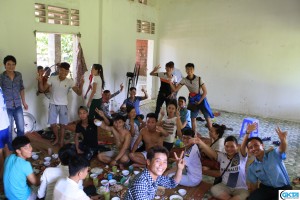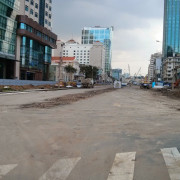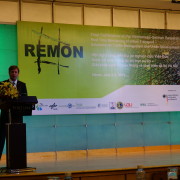Vietnam 2014: Year in Review
Firsts and Notable Events
Tomorrow is the last day of the year in the Gregorian calendar but the Year of the Horse in the Vietnamese lunar calendar extends until mid February, 2015. Overall, 2014 marked many firsts for Vietnam: the first McDonald’s opened in Ho Chi Minh City shortly before Tet (the lunar new year). The first Rolls-Royce dealership opened in Hanoi in August, and the first mobile game out of Vietnam, Flappy Bird, went viral (and is now currently only officially available on Amazon Fire TV). Notably, Lotte Center Hanoi opened on September 2, Vietnam’s Independence Day, (after five years of construction) and Formation 8 sponsored a bi-city Hackathon, demonstrating that there is continued interest in the growing startup ecosystem in Vietnam from outside investors.
More recently on Christmas Day (December 25) Hanoi received a “gift” in the form of the new airport terminal that opened for its first flight but the terminal won’t be fully operational until December 31. The four-story, 139,000 square meter Terminal 2 has cost several hundred million dollars to build and it will accommodate a growing number of travelers to Vietnam. However, not all of 2014 happenings were rosy; the falling price of oil, anti-China protests in the middle of the year, and continued reports of Vietnam’s public debt increasing were some of the more worrisome developments during the past year.
Trade Impacts: Sanctions and Price Swings
In the last six months the price of oil has dropped by 40% and it’s certainly quite a different situation from this time of the year in 2007 as oil was about to break the $100 per barrel mark. Consumers in the west will certainly enjoy going to the gas stations once again and the increased disposable income will provide short term benefits for their economies. Similarly, the price of gas in Vietnam has been falling as well, as it is regulated by the Ministry of Finance and the Ministry of Industry and Trade. We will most likely see a cycle of global oil production slowing down, new oil projects put on hold, and then the price of oil skyrocketing back up, perhaps even before the end of next year.
For 2015, Vietnam’s GDP was projected to grow 6.2% if the price of oil had stayed at $100 per barrel and for every $1 the price of a barrel of oil loses, the State budget would lose VND 1-1.2 trillion (approximately $5.1 million). Oil export revenue makes up an estimated 10.2% of the total budget revenue which is lower than in previous years. However, the budget revenue target is VND 911.1 trillion (over $42 billion) so the change in the price of oil still impacts the budget and will continue to as the price of oil continues to fluctuate.
At the same time, EU and US sanctions against Russia (and the Russian counter-sanctions) also provide an opportunity for Vietnam to increase its exports (in particular seafood and fruit) to Russian consumers, who will still demand or need products that were readily available to them earlier this year. The complicating factor for Vietnamese exporters will be the declining value of the Russian ruble, currently in free fall (and valued at approximately half of its worth at this time last year). Still, Vietnam and Russia recently concluded negotiations for the Customs Union agreement, which is expected to increase trade between the two countries to $10 billion by 2020.
Changing Skylines and Construction Interruptions
If you’ve been to Nguyen Hue street in Saigon’s District 1 recently then you know what a eyesore the metro construction project has been there (and in District 2). Earlier this year, the cost projections for the project were revised from $1.1 billion to a staggering $2.7 billion. On the opposite side of the country, the $1 billion metro project in Hanoi hasn’t progressed much since construction began in 2012. Completion dates for both projects keep getting pushed back as well—something that will most likely continue to happen before the current projected completion dates.
Now is construction season in Hanoi, mostly due to the cooler weather and attempts to finish projects before Tet so families can spend the holiday in their new homes. However, for the neighbors of such a construction project it can mean a significant decline in the quality of life for the duration of demolition and building. Construction can begin anywhere from 5:30 to 6:30 AM every day of the week and last until 6:30 PM with a break in the middle of the day for a lunch and siesta (usually one to two hours). At night, trucks delivering supplies for the next workday can arrive at 11:00 PM, 1:00 AM, and 3:00 AM due to lack of required permits to transport the goods during the day. For residential construction in narrow alleyways, workers can block nearby entrances, leave a mess, and contribute to the local noise and air pollution with jackhammers and gas-powered pulleys (in the last six months, your author has experienced three such projects). Surprisingly, many Vietnamese don’t seem to mind the noise and delays, unless they are traffic related.
For a changing city, cranes perched across a skyline are the sight of progress. But perhaps the costs of construction projects can also be measured in psychological effects due to the disruption in daily schedules. The noise of progress is far more intruding than the sight of progress and it has lasting impacts on future generations. Still, if not construction then other sonic interruptions such as public karaoke, horn honking, or motorcycle engine revving will emerge through the city soundscape. For sure, anyone who has visited Hanoi has learned to appreciate silence in this loud, chaotic, and flowing city.
Clear Winners
In 2014, Korea and Japan deepened their relationships with Vietnam on cultural, educational, and economic levels. Additionally, Vietnam established or renegotiated a number of bi-lateral trade agreements with states such as Lao PDR, Israel, Macedonia, and others.
Additionally, Samsung selected Vietnam as the location for a $3 billion manufacturing facility. It already has a $2 billion plant here so Samsung’s selection of Vietnam shows its faith that Vietnam’s business climate will continue to meet Samsung’s future production needs; this development continues the trend of manufacturing shifting away from China. Vietnam’s largest export value for 2014 is still cellphones and components—something that has remained unchanged since last year.
Furthermore, Mercedes-Benz Vietnam had the best first-half of the year ever since setting up in Vietnam— and one could make the case that it’s the unofficial vehicle brand of Hanoi given how seemingly ubiquitous the models are throughout the city. It will be interesting to see how the brand finishes out the year once the final numbers moved are tallied. To that extent, luxury brands here continued to do well, overall (though there are emerging signs that some Vietnamese may be living beyond their means).
Last but not least, the World Cup was a huge winner in 2014, no doubt causing the loss of serious amounts of productivity over the summer as Vietnamese workers stayed up until 5:00 AM or later to catch the games in Brazil. Not everyone was a winner though, as those who gambled away their fortunes or homes were left with low spirits. Still, the World Cup was a chance for Vietnamese families and friends to get together and share the communal experience of watching the nation’s undisputed favorite sport.
Undoubtedly, 2014 was many things for Vietnam (not all of it covered in this post), but it certainly wasn’t dull. We hope that you will continue to join us in 2015 as Vietnam and Southeast Asia continue to ascend. Happy New Year to you and yours wherever you are in the world!










